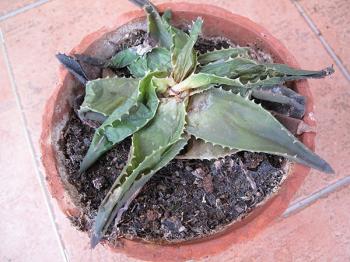April 13, 2019
Shocking Houseplants when Transitioning Outside
Reprint from April 2011. Written by Dr. Curtis Smith, retired NMSU Extension Horticulture Specialist, with additions by Dr. Marisa Thompson.
Question:
Is it safe to put houseplants outside now? After I moved my plants outside last year most of the leaves died.
- M.J., Albuquerque
Answer:
In the Albuquerque area, it will soon be safe to put houseplants outside for the summer. If you are in the valley or high-elevation areas, you may need to wait until the second week of May. Gardeners in southern New Mexico can be more confident moving plants outside already (except those at high elevation). In northern New Mexico, gardeners should wait another month or more.

In any event, you should watch the weather reports and be prepared to move plants back indoors or cover them. Frost and freezes are increasingly unlikely, but not unheard of this late in areas of the Middle Rio Grande.
The loss of leaves last year could be due to several causes. Leaves formed under low light conditions indoors will take time to adapt to bright light or full sunlight conditions outside. The plant will form new leaves adapted to the new light levels, but the old leaves may burn or look bleached before the new ones have a chance to develop. You can minimize the impact of changing light conditions on the plants by first moving them outside to a relatively shady location, and then gradually move them to brighter spots until they are in the place you will keep them for the summer. This gives the plant time to adapt by forming new leaves and, in some plants, to increase the light tolerance of existing leaves. At least the plants should not totally defoliate.
Dry winds can also cause leaf loss. Plants that have been protected all winter may not tolerate our outdoor winds well. Move them first to a location sheltered from the wind. Even in mid-summer, winds can cause leaf damage. Anyone who’s babied a bougainvillea all winter indoors just to see it completely defoliate in the first hours out on the patio in April knows this struggle. Those tiny new leaves never stood a chance.
The plants may also experience more rapid drying of the soil when placed outside. Plants growing outside may lose water from the soil through the soil surface, the walls of unglazed clay pots, and their leaves more rapidly than when they were inside. You may need to alter your watering frequency when you take the plants outside.
A period of cold weather can also cause loss of existing leaves. Some tropical plants can be injured by temperatures well above freezing. Such plants should be kept indoors until night temperatures are consistently above 50 degrees, or should first be placed in a sheltered location where the night temperatures will remain above 50 degrees.
When you move your plants outside you should give the plants protection to allow them to adapt to new growing conditions, and you should alter your cultivation practices to accommodate the new environment in which you grow your plants. If you make a mistake and shock your poor plant, help the rest of us feel less guilty by snapping a photo and sharing it on Instagram or Facebook at @NMDesertBlooms.
Marisa Y. Thompson, PhD, is the Extension Horticulture Specialist, in the Department of Extension Plant Sciences at the New Mexico State University Los Lunas Agricultural Science Center, email: desertblooms@nmsu.edu, office: 505-865-7340, ext. 113.
Links:
For more gardening information, visit the NMSU Extension Horticulture page at Desert Blooms and the NMSU Horticulture Publications page.
Send gardening questions to Southwest Yard and Garden - Attn: Dr. Marisa Thompson at desertblooms@nmsu.edu, or at the Desert Blooms Facebook page.
Please copy your County Extension Agent and indicate your county of residence when you submit your question!